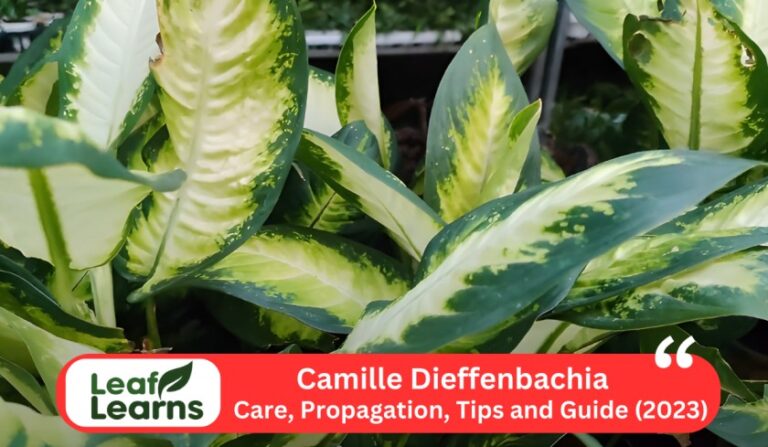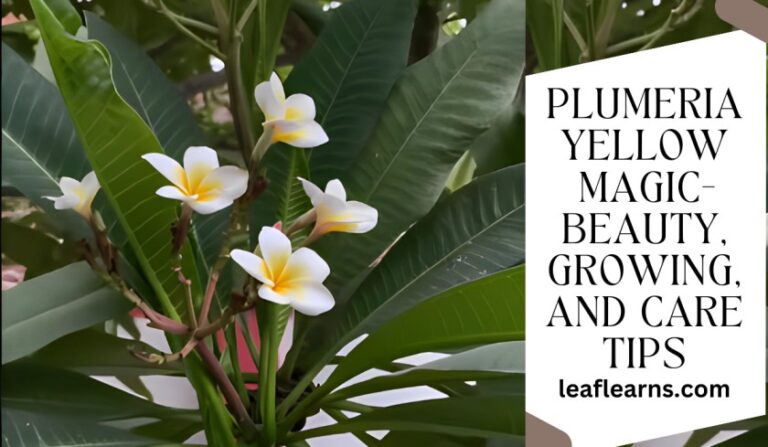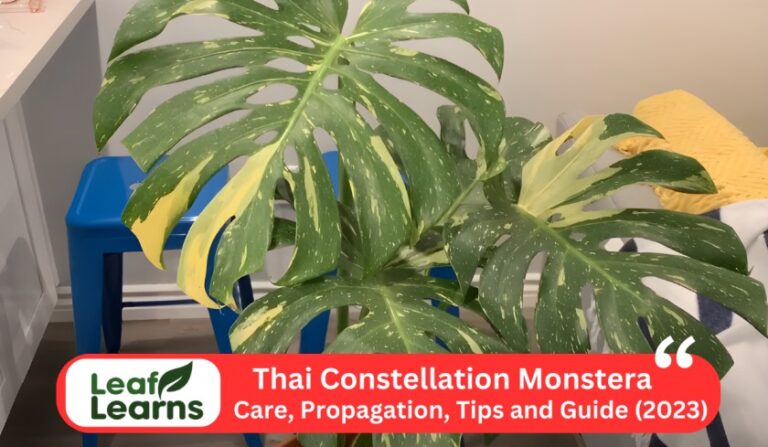Rhipsalis Cereuscula ‘Rice Cactus’ Care and Grow (2023)
As well as adding a touch of the exotic to any home, Rhipsalis cereuscula, also known as the Rice Cactus, is a captivating plant. The unique cactus, native to tropical South America, stands out among its more prickly relatives thanks to its curious characteristics. We will explore the unique nature of the Rhipsalis cereuscula, explore its definition, and uncover its care requirements. The scientific name of rice cactus is Rhipsalis Cereuscula.
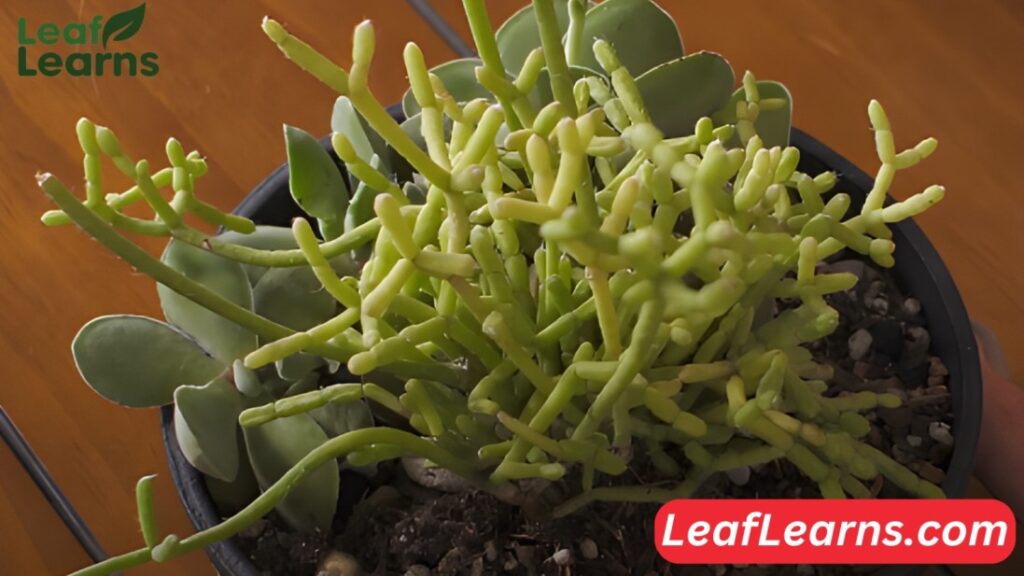
Contents
- 1 What is a Rhipsalis Cereuscula?
- 2 What’s Unique About Rhipsalis-Cereuscula?
- 3 Top Care Tips
- 4 Care for Rhipsalis cereuscula
- 5 Rhipsalis cereuscula Propagation
- 6 Growing Problems
- 7 Rhipsalis Cereuscula Pruning
- 8 Repotting
- 9 How to Get Rice Cactus to Bloom
- 10 Rhipsalis Cereuscula Growth Rate and Size
- 11 Flower and Foliage
- 12 Rhipsalis Cereuscula or Rice Cactus Flower
- 13 Appearance and Fragrance
- 14 Underwatering And Overwatering
- 15 Pests
- 16 Diseases
- 17 Problems and Solutions
- 18 Toxicity
- 19 Rhipsalis Cereuscula toxic to cats and dogs
- 20 Varieties/Types
- 21 Uses and benefits
- 22 Cultivating a Thriving Coral Cactus
- 23 A Comprehensive Care Manual for This Unique Variety
- 24 Conclusion
- 25 FAQs
What is a Rhipsalis Cereuscula?
It clings to tree branches and rock crevices in the wild rather than living in the desert like its desert-dwelling cousins. Its long, slender stems are adorned with small, cylindrical segments resembling rice grains and it grows on other plants without harming them.
| Common Name | Rice cactus, Coral cactus, Mistletoe Cactus |
| Scientific Name | Rhipsalis-cereuscula |
| Family | Cactaceae |
| Origin | Native to Central and South America |
| Plant Type | Epiphytic cactus |
| Size | Compact, typically 6 to 12 inches (15 to 30 cm) |
| Lifespan | Perennial |
| Leaf Colour | Bright to dark green |
| Leaf Size | Small, thin, and elongated |
| Flower | Small white to cream flowers |
| Light | Bright, indirect light |
| Water | Moderate water, allow soil to dry between waterings |
| Soil | Well-draining cactus or orchid mix |
| Temperature | Average room temperatures, avoid extreme cold or heat |
| Humidity | Tolerates average indoor humidity levels |
| USDA Zone | 10-11 |
| Fertilizer | Diluted cactus fertilizer during the growing season |
| Propagation | Stem cuttings or offsets |
| Pruning | Minimal pruning for shape and size control |
| Pests | Generally pest-resistant; watch for spider mites |
| Toxicity | Non-toxic to humans, cats, and dogs |
| Uses | Indoor decoration, hanging baskets, ornamental plant |

It is crucial to understand Rhipsalis-cereuscula’s unique characteristics and care requirements in order to ensure its long-term health and survival. You can add an exotic touch to your living space by providing this cactus with the right environment and care.
Where to plant
Known for its cascading, pearl-like segments, Rice Cactus thrives in environments that mimic its natural environment. Your plants will live a happy and healthy life if you follow this guide, both indoors and outdoors.
Indoor Oasis
- Dappled sunlight: Your Rhipsalis enjoys the filtered light that filters through rainforest canopies. The best windows are those facing south or east.
- Plants thrive in humid environments, so mist them regularly or place them in a pebble tray filled with water. Natural humid environments, such as bathrooms or kitchens, are ideal.
- An epiphyte or succulent should be planted in well-draining soil. Drainage holes should be provided in the pot to prevent waterlogging.
Outdoor Sanctuary
- A partial shade will prevent the delicate segments from being scorched by harsh, direct sunlight. An open canopy tree or shaded patio creates the perfect balance.
- Protect your Rhipsalis from harsh weather conditions and strong winds. Ideal locations are balconies and porches that are sheltered.
- If you want to replicate the natural climbing habit of your Rhipsalis, you can mount it on a bark slab or driftwood.
Grooming & Maintenance
- You can encourage bushier growth by pinching off leggy stems and removing dead or discolored segments on a regular basis.
- During spring and summer, fertilize every two to three weeks with a balanced, diluted liquid fertilizer.
- The soil should be thoroughly watered when it feels dry on top. You should avoid overwatering in order to prevent root rot.
Choosing Your Cultivar
- R. cereuscula ‘Coral Bells’: Shows charming, bell-shaped segments in coral and pink shades.
- R. cereuscula ‘Flabelliformis‘: The segmentation is flat and fan-like with attractive variegation.
- R. cereuscula ‘Variegata’: The green segments of this cultivar are variegated with white cream.
What’s Unique About Rhipsalis-Cereuscula?
During the summer, this epiphytic cactus’ dainty, tubular white flowers bloom on other plants, giving it a delicate beauty. A touch of whimsy can be brought to any indoor space with this compact hanging basket.
Here’s what makes special
- This cactus is distinguished by its rice-like stems instead of spines, giving it a graceful appearance.
- Flowers are delicate and tubular in shape, adding an elegant touch to Rice Cactus in summer.
- Easily grown in hanging baskets and terrariums, this cactus makes a great addition to small spaces or to any room that needs a little greenery.
Top Care Tips
- When the soil feels dry to the touch, water your plant deeply, but let it dry completely before watering again.
- A bright indirect light is preferable.
- Temperature: This plant prefers a warm environment, between 60 and 85 degrees Fahrenheit (15 and 29 degrees Celsius).
- It prefers moderate humidity, but can tolerate dry conditions.
- In the spring and summer, fertilize this plant with a balanced liquid fertilizer once a month.
Care for Rhipsalis cereuscula

Light Requirement
Bright, indirect light is the best environment for Rice Cactus, a cascading cactus with whimsical charm. A rainforest canopy is dappled with sunlight.
The summer months are the best time for indirect lighting, so provide a consistent amount during these months.
The best windows are those that face east or north. Be careful not to expose it to harsh afternoon rays, which can damage its delicate foliage.
Rhipsalis can tolerate a little less light in winter as the days become shorter. Do not place it in a dark corner, however. It is sufficient to have a window facing south (not in direct sunlight) or filtered light in the room.
There is a perfect balance between spring and fall during these transitional seasons. You will keep your plant happy by placing your window east or west, with a mix of morning and afternoon sunlight and bright indirect light.
Water Requirements
There is no need to water Rhipsalis-Cereuscula between waterings, as it prefers its soil to dry completely between waterings. When succulents are overwatered, root rot is common. This mimics their natural habitat.
Seasonal Watering Schedule
- The soil should be allowed to dry completely between waterings in the summer. Water deeply once a week. Two weeks’ worth of watering may be necessary during particularly hot stretches.
- Restrict watering to twice or three times per week in winter. Plants need less water when temperatures are cooler and sunlight is reduced.
- It is time to transition from summer watering schedules to winter watering schedules in the spring and fall. Depending on the humidity and growth of the plant, water deeply once every 10-14 days.
Soil Requirement
Your plant will thrive in soil that drains well, contains a small amount of acidity, and has good air circulation. Peat moss and perlite are good organic matter for jungle floors, along with some orchid bark for structure. Don’t forget about drainage!
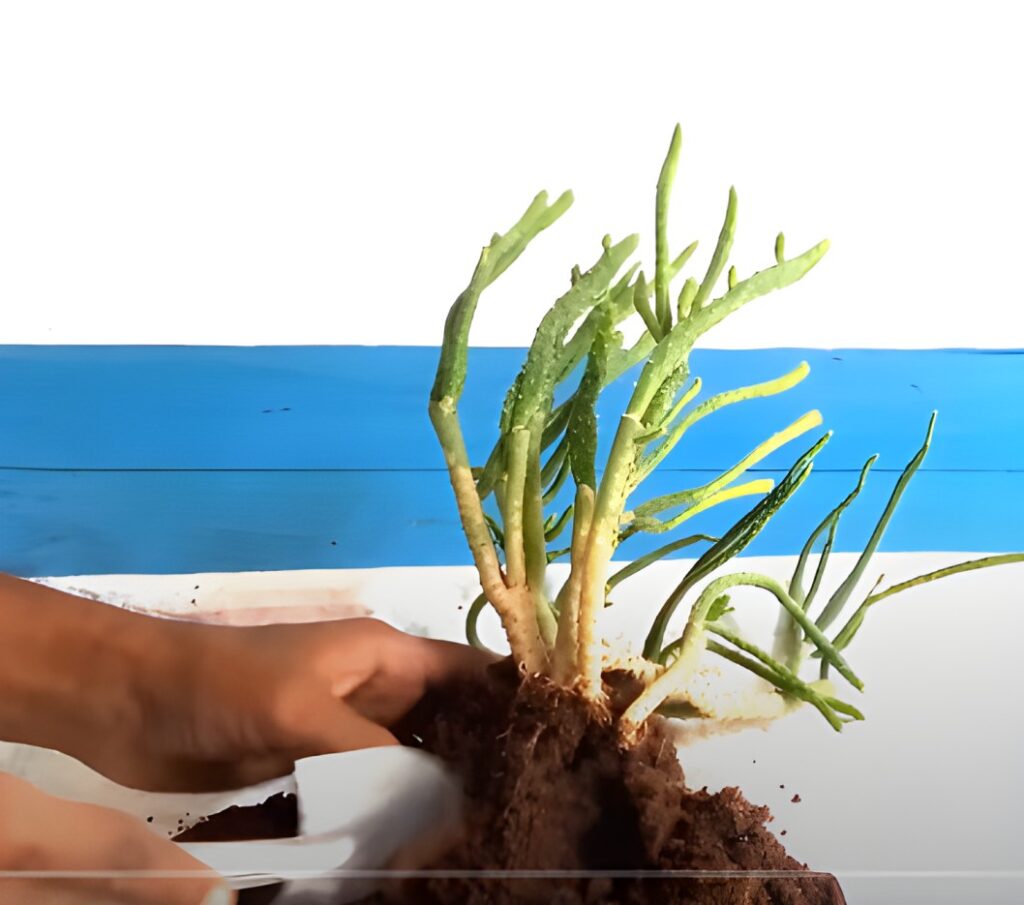
Maintain a slight dampness in the soil in summer, but do not let it become soggy. Reduce the frequency of watering as autumn approaches, allowing the soil to dry out more between waterings.
A gentle drink of water every few weeks is all that is needed during winter. When spring comes, your Rhipsalis will awaken, so slowly increase its watering to see what happens!
Temperature Requirement
In warm environments, the mysterious Rice Cactus thrives as the mistletoe or coral cactus. Temperature needs vary from season to season, so here’s a quick guide:
During summer, keep your daytime temperature between 70 and 75°F (21-24°C) and your nighttime temperature between 60 and 70°F (16-21°C). The natural rainforest habitat mimics the plant’s optimal growth environment.
A Rhipsalis plant can tolerate 59°F (15°C) in the winter, even though it isn’t cold-hardy. Be careful not to stress the plant with sudden temperature changes or drafts.
It’s a breeze to transition from spring to fall. Temperatures should be kept between 65 and 75°F (18-24°C) during the day and 55 to 65°F (13-18°C) at night.
The Rhipsalis Cereuscula can reach heights of up to 8 feet (2.4 meters) if properly cared for and supported.
Humidity Requirement
A humid environment is optimal for Coral Cactus.
Throughout the year, it needs the following humidity:
It is recommended to keep the humidity between 50-60% during the summer. Using a pebble tray or misting the plant regularly will help.
Low humidity (40-50%) is tolerated by the plant during winter. Heat sources or radiators should be avoided.
The humidity should be moderate during spring and fall (45-55%). Set up a mini microclimate with your Rhipsalis and other plants.
Remember:
- There is usually 45-50% humidity in an average home.
- Use a hygrometer to measure humidity.
- Leaves can brown if the air is dry, and the growth can be stunted if the air is dry.
Rice Cactus Fertilizer Requirement
You can boost the growth of your Rice Cactus by fertilizing it, although it is not strictly necessary. Here’s a quick guide for different seasons:
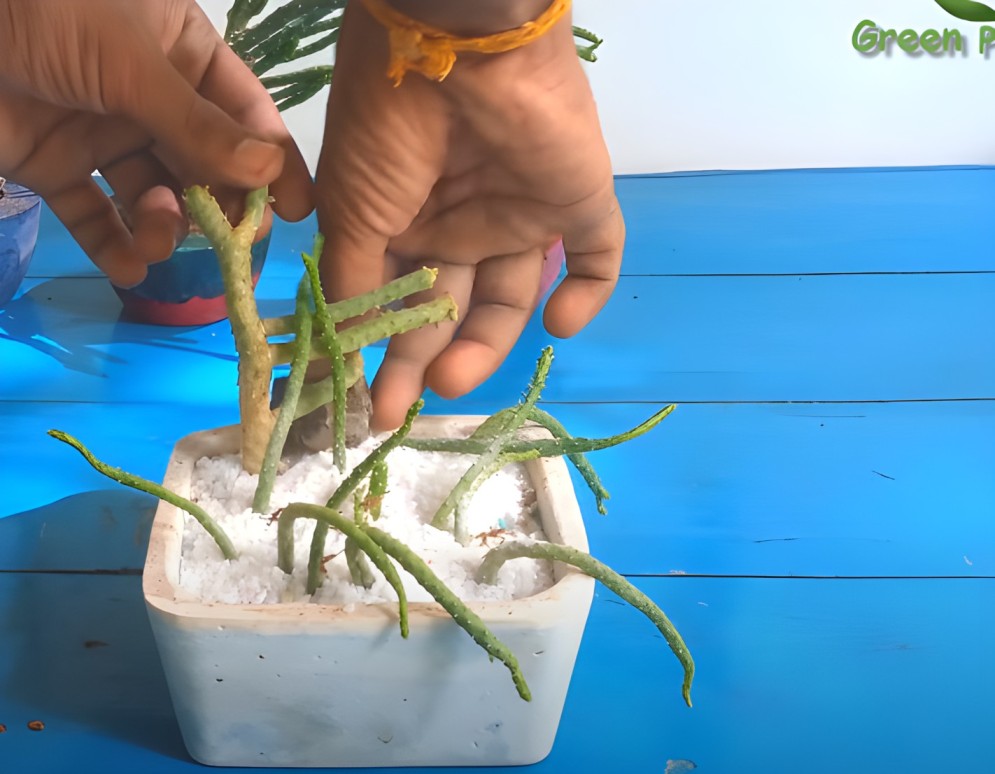
In the summer, feed with a half-strength liquid fertilizer diluted with a balanced liquid fertilizer. Plants will benefit from the extra nutrients during this peak growing season.
During spring and fall, fertilization should be reduced to once a month. Fertilizer needs to be applied less frequently as the plant’s growth slows down.
Winter: Avoid fertilizing during the winter months. You don’t need to feed your plant since it is dormant.
Choosing the Right Fertilizer:
- A balanced liquid fertilizer with an 8-8-8 or 10-10-10 N-P-K ratio is best.
- The fertilizer should be diluted according to the instructions provided by the manufacturer. Roots can be damaged by over-fertilization.
- Before applying fertilizer, make sure your plant is thoroughly watered. Root burn can be prevented by doing this.
Potting Requirement
In summer, use a mix that drains quickly, has plenty of air, and contains a small amount of peat moss. The drainage is excellent and root rot is avoided during the summer months when it is hot and humid.
Switch to a slightly denser mix during the winter months. The addition of peat moss increases moisture retention without compromising drainage. The Rhipsalis will be able to cope with the dry air of winter this way.
Potting mix should be adjusted as the seasons change. The amount of peat moss should be gradually increased or decreased depending on the temperature and humidity.
Additional Tips:
- Size of pot: Choose a pot one inch wider than what you previously used. A slightly rootbound Rhipsalis-Cereuscula is preferable.
- In order to prevent waterlogging, ensure your pot has drainage holes.
- Make sure the pot is breathable, such as clay or terracotta, to prevent root rot.
Rhipsalis cereuscula Propagation
There are three main methods to propagate your plant:
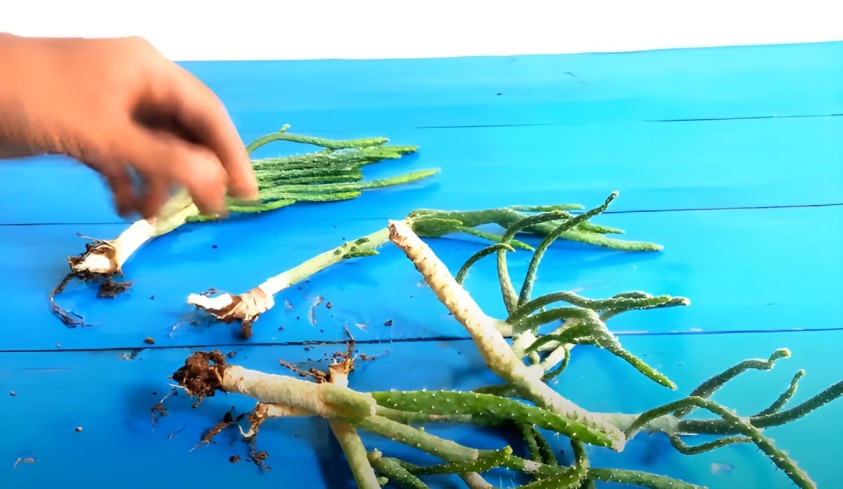
Stem Cuttings
This is the most common and straightforward method. Here’s how:
- Make sure your champion stem is healthy, mature, and at least 4 inches long. Those with blemishes or illness symptoms should be avoided.
- Ensure the safety of your tools: Ensure that knives and scissors are sterilized before use.
- Hooray for snipping! Snip the leaves just below the nodes (the bump where leaves arise) at a 45-degree angle. It is possible to create multiple plants by taking several cuttings if you are feeling ambitious.
- For the first few days after cutting, let the cuttings rest in a warm, dry place away from direct sunlight. It prevents rot and encourages root development by forming a protective layer over the cut.
- You can pot succulents and cacti together by filling a small pot with well-draining cactus mix. Keep the soil slightly moist, but do not soak it.
- Embrace a new beginning by carefully inserting the calloused end of your cutting into the soil. Make sure the soil is firm around the base so it can support the plant.
- It is important to keep the cutting in bright, indirect light and water it sparingly. Overwatering should be avoided, and patience is key! In most cases, rooting takes between two and four weeks.
- You have waited long enough: Rejoice! The cutting has successfully rooted when new growth emerges!
Offsets Methods
Rice Cactus varieties readily produce offspring, which are essentially baby plants. The following steps will help you separate them:
- Look for small, growing plantlets near the stem’s base. Prior to separating them, make sure each has its own little roots.
- You can gently persuade the mother plant to remove the offset by using clean hands or sterilized tools. You should be gentle with both plants in order to avoid damaging them.
- Offsets should be planted in small pots with well-draining soil and cared for in the same manner as stem cuttings.
Watering for a New Life
Observation and patience are required for this method, but it can be very rewarding. Here’s how:
- Taking a healthy leaf and carefully twisting it, it should naturally detach itself from the stem.
- The leaf should be laid flat on a moist mixture of cactus and succulents in a small pot. Make sure there are drainage holes in the pot, and don’t bury it.
- Use a plastic bag or cloche to create a humid environment. In order to prevent mold growth, make sure you remove it daily to allow air circulation.
- Water carefully: Never let the soil become soggy. New growth can take several weeks to appear, so patience is key.
Remember
- It is best to avoid fungal infections by using sterilized tools.
- If you want your cuttings or offsets to grow optimally, give them bright, indirect light.
- It is important not to overwater your plants, since this is one of the most common reasons for failure.
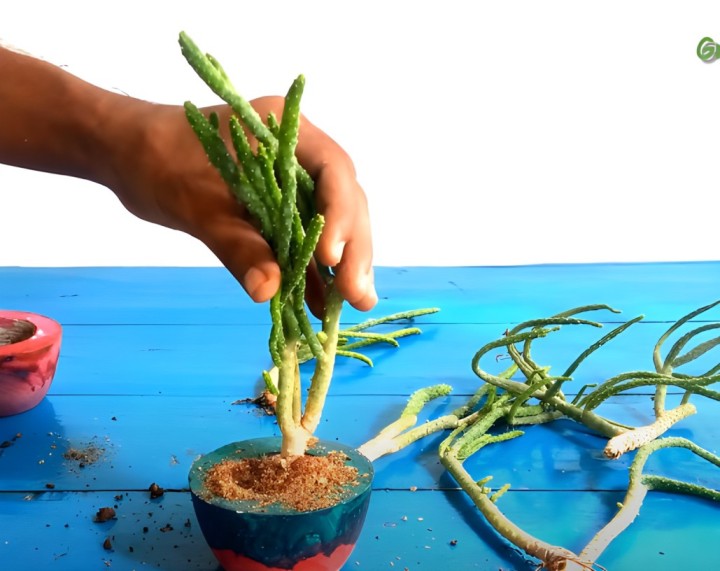
Growing Problems
Yellowing leaves (overwatering alert! ), leggy growth (pruning required), and mealybugs are a few things to watch for. Consider adjusting your watering habits, increasing light, and taking action against pests.
Rhipsalis Cereuscula Pruning
- Why prune? It is mainly for aesthetic purposes that trees are pruned. Your plants can be kept in shape by trimming off leggy stems, removing damaged or diseased parts, or simply trimming off leggy stems to promote bushier growth.
- When to prune? It is generally considered that spring is the best time to prune, although you can prune at any time.
- How to prune? Make clean cuts at the desired points using sterilized shears or scissors. Remove only a small amount of foliage at a time.
Repotting
- Why repot? Whenever the plant outgrows its pot or the soil becomes depleted of nutrients, it needs to be replanted. Repotting usually takes place every 2-3 years.
- When to repot? The best time to repot is again in the spring.
- How to repot? Ensure the pot you choose has good drainage holes and is only slightly larger than the current one. Make sure the cactus and succulent mix you use is fresh and well-draining.
Gently loosen any compacted roots by removing the plant from its old pot. Fill the new pot with fresh soil and place it in the new pot. For a few days, avoid direct sunlight and water lightly.
How to Get Rice Cactus to Bloom
In addition to its cascading stems, Rhipsalis-cereuscula blooms add an additional dimension of beauty. Here’s how to coax your coral cactus into producing its delicate white flowers:
- 1. Provide bright, indirect light to enhance its life. Sunlight can scorch leaves, so avoid direct exposure.
- 2. The temperature should be between 60 and 85 degrees Fahrenheit (15 and 29 degrees Celsius). You should avoid drafts that are cold.
- 3. Let the top 12.5 inches of soil dry out between waterings throughout the pre-flowering period.
- 4. Water only enough for 3-6 weeks after flowering to keep the soil barely moist. Keep it cool for two months (around 55°F) to trigger bud growth.
- 5. Fertilize monthly with diluted liquid fertilizers during the growing season (spring and summer).
Rhipsalis Cereuscula Growth Rate and Size
Rice Cactus grows slowly over time but reaches impressive heights. In spite of its slow growth, its cascading stems can grow up to 3 feet long, and the plant itself can grow as high as 20 feet.
Though its growth rate seems slow, don’t be discouraged! It requires relatively little maintenance, making it suitable for those who don’t have a lot of time for gardening.
Flower and Foliage
Foliage
- The color is lush green
- Approximately 1/4 inch in length, tiny
- Forms elegant, cascading stems reminiscent of coral reefs, with cylindrical, segmented, and slightly flattened shapes.
Rhipsalis Cereuscula or Rice Cactus Flower
- Usually white, sometimes pink or purple in color
- Having long, narrow, and pointed sepals, this flower is star-shaped
- Approximately 1/2 inch wide, small
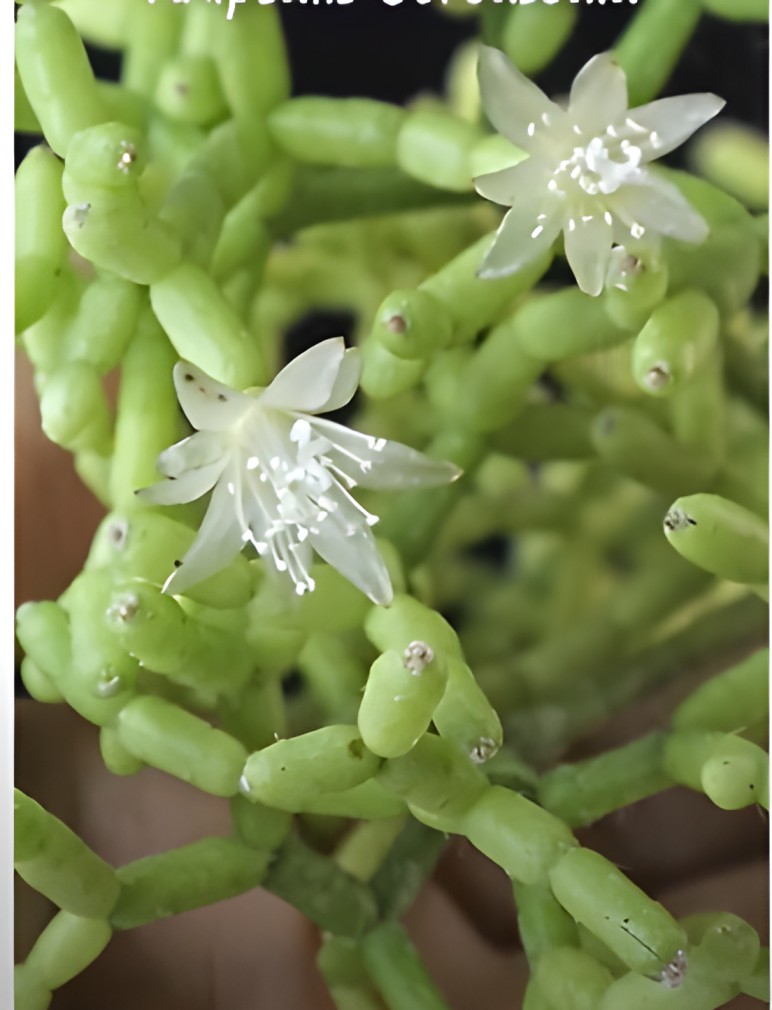
Blooming Season
- The plant usually blooms in spring and summer, but it can occasionally bloom throughout the year with proper care.
Appearance and Fragrance
Cactuses like the Rhipsalis-cereuscula, affectionately called the “Coral Cactus,” are captivating. A touch of whimsy is added to any interior with its cascading stems that resemble delicate coral branches.
Cladodes, which are modified leaves, can be found on these stems. Some variety boast a reddish hue, while others range from vibrant greens to soft, muted greens. There are often segments on the cladodes, adding to the intricate beauty of the plant.
The Rice Cactus may catch the attention of many with its unique appearance, but its fragrance is very delicate. Others report that they cannot detect the scent at all, while others describe it as subtle, sweet. In spite of its graceful form and lush greenery, the plant’s overall appeal lies in its graceful form and lush greenery.
Underwatering And Overwatering
It is just like any good friend to make sure that your Rhipsalis-cereuscula thrives. In extreme cases, it can go into a tailspin if it receives too much or too little water.
Underwatering
- There are signs of drought, such as wrinkled leaves, stunted growth, and a dry feel to the soil.
- Ensure the drainage holes of your plant are filled with water by giving it a deep watering. Water the soil again after it has dried completely.
Overwatering
- The leaves are yellow, the stems are soft and mushy, the soil is soggy, and the roots are rotten.
- Check the roots of the plant by removing it from the pot. With sterilized shears, trim off any brown and mushy ones. Water the plant less frequently and repot it in fresh, well-draining soil.
Pests
- The mealybugs feed on sap from leaves and stems, leaving sticky honeydew behind. With rubbing alcohol dipped cotton swabs, remove them.
- During the summer, spider mites cause yellowing and stippling of leaves by spinning webs and feeding on the leaves. Make use of insecticidal soap or neem oil to get rid of them.
- A scale insect is a small, armor-covered insect that feeds on sap from leaves and stems. You can either scrape them off with a fingernail or apply horticultural oil to them.
Diseases
- Overwatering causes root rot, a fungus that can kill plants. The leaves of the plant turn yellow, their growth is stunted, and the roots become mushy. It is important not to overwater the plant when repotting it in fresh soil.
- Symptoms of powdery mildew include white, powdery mold covering leaves and stems, which can impede the growth of plants. Mix baking soda with water or use fungicide.
Problems and Solutions
Problem: Yellowing or Dropping Leaves
Solution: Make sure the soil drains well and adjust the frequency of watering.
Problem: Leggy Growth and Sparse Foliage
Solution: Provide indirect light and prune to promote bushier growth.
Problem: Root Rot Due to Excess Moisture
Solution: Ensure proper drainage in the pot and let the soil dry between waterings.
Problem: Lack of Flowering
Solution: During the growing season, adjust fertilizer routines as necessary.
Problem: Pests, such as Spider Mites
Solution: Check your plant regularly and treat if pests are detected with neem oil or insecticidal soap.
Problem: Wilting or Drooping
Solution: Make sure plants receive adequate water without becoming waterlogged by adjusting watering habits.
Problem: Stunted Growth
Solution: Make sure light conditions are proper, fertilize occasionally, and use the right pot size.
Problem: Brown or Soft Spots on Leaves
Solution: Maintain good watering practices, avoid sitting water on leaves, and improve air circulation.
Problem: Mold or Fungal Issues
Solution: Make sure the plant has adequate ventilation, avoid overwatering, and apply fungicide if necessary.
Problem: Leaf Edges Turning Brown
Solution: Make sure humidity levels are adjusted and don’t place plants near drafts or heaters.
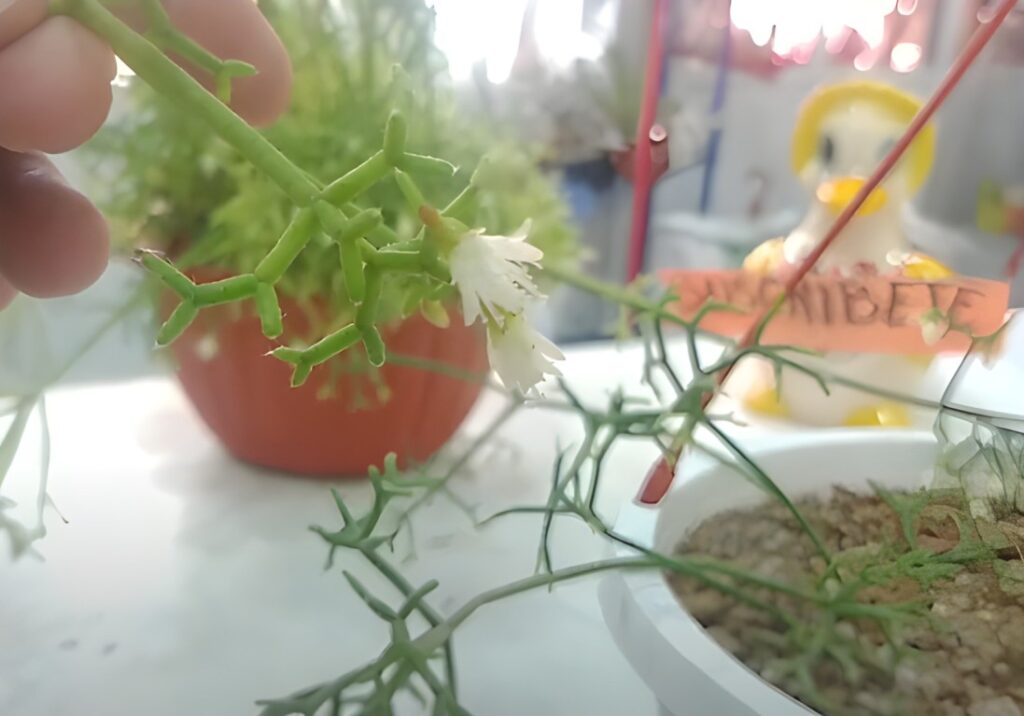
Toxicity
It is Toxic for humans. When consumed or applied to the skin, the sap can cause irritation in humans. It is possible to experience nausea, vomiting, and diarrhea as a result of ingestion.
Rhipsalis Cereuscula toxic to cats and dogs
In cats and dogs, the sap can cause similar digestive issues and skin irritations, though it is not considered highly toxic . Ingestion of any parts of the plant should be treated by a veterinarian.
Key takeaways
- Despite being not deadly, Your plant should be kept away from pets and children.
- If you handle the plant, you should wear gloves to avoid irritating your skin.
- Consider seeking medical attention if you suspect ingestion.
Varieties/Types
Rhipsalis-cereuscula Haworth
- Coral Cactus is a classic. This variety is characterized by its long, slender stems that gently drape downwards, giving it the appearance of coral.
Rhipsalis-cereuscula ‘Variegata’
- There is a creamy white variegation on the stems of this stunning variety. Adding this to your plant collection adds an additional layer of visual interest.
Rhipsalis-cereuscula ‘Flabellata’
- In contrast to the typical cylindrical stems, these segments are flattened, paddle-shaped. Adding sculptural elements to your home is easy with this unique shape.
Rhipsalis-cereuscula ‘Cristata’
- The growth pattern of this rare and fascinating variety is characterized by crested growth. Creating a truly eye-catching specimen, the stems are flattened and fan-shaped.
Rhipsalis-cereuscula ‘Monstrose’
- As compared to Rhipsalis-cereuscula, this variety has thick, fleshy stems. Adding this to your plant collection will make it look bold and substantial.
Rhipsalis-cereuscula ‘Penduliflora’
- With long, cascading stems that can reach several feet long, this variety is one of the most attractive varieties.
Rhipsalis-cereuscula ‘Nana’
- Bringing greenery to a small space is easy with this miniature version of the classic Coral Cactus.
Rhipsalis-cereuscula ‘Rubra’
- Your indoor jungle will pop with color from this variety’s reddish-pink stems.
Rhipsalis-cereuscula ‘Superba’
- You can add a bolder presence to your plant collection with this Rhipsalis-cereuscula variety, which has thicker, more substantial stems than the typical Rice Cactus.
Rhipsalis-cereuscula ‘Argentea’
- Silvery-green stems give this variety a unique appearance.
Uses and benefits
- The Rhipsalis-cereuscula is a good air purifier and helps filter out toxins in the home. Benzene and formaldehyde, common household pollutants, are particularly effective at removing them.
- Researchers have found that interacting with plants reduces stress and anxiety.
- Shelf, desk, or hanging baskets are sure to be captured by its cascading form and unique texture.
- The Rhipsalis-cereuscula thrives with minimal care, unlike some other houseplants.
Unconventional Uses
- Rice Cactus shoots are consumed as leafy vegetables in some regions. Cooked or raw, they are said to have a slightly sour taste.
- Researchers are still studying Rice Cactus, but some studies indicate that it may possess medicinal properties. In addition to antimicrobial properties, it also has anti-inflammatory and anticancer properties.
- It is also less energy-consuming and requires fewer resources, which reduces its environmental impact.
Cultivating a Thriving Coral Cactus
Caring for coral cactus, involves a variety of considerations to ensure its optimal growth and well-being. Proper care includes understanding its unique characteristics such as its flowering process (blüte) and the potential toxicity to cats.
To nurture a healthy coral cactus, it’s essential to provide suitable conditions for growth, including the right soil, watering regimen, and exposure to light. Additionally, propagating Rhipsalis-cereuscula through methods like bouture or stekken can be explored for expanding your collection.
Regular care practices, such as adequate watering (gießen) and protection from extreme conditions, contribute to the overall success of cultivating this intriguing plant.
Whether you’re an experienced plant enthusiast or a novice, learning about Rhipsalis-cereuscula care is crucial for fostering a thriving and visually appealing coral cactus in your indoor or outdoor space.
A Comprehensive Care Manual for This Unique Variety
Moving on to Rhipsalis cassutha care, this cluster encompasses a comprehensive guide to maintaining the well-being of this specific Rhipsalis variety. From understanding its unique features and flowering patterns (blüte) to addressing its care needs, Rhipsalis cassutha presents its own set of considerations.
Whether you’re dealing with concerns about soil (erde) composition or seeking insights into watering practices (regar) and potential toxicity to pets (giftig katze), this cluster covers it all.
The diverse aspects of care, including soil preferences, exposure conditions, and propagation techniques (vermehren), are essential components for successfully nurturing Rhipsalis cassutha.
Whether you are looking for care tips for an established Rhipsalis cassutha or planning to introduce a new one to your plant collection, understanding its specific requirements is key to promoting its health and longevity.
Conclusion
Rice cactus stands out among the captivating realm of houseplants, offering a unique and alluring aesthetic to any residence. Its delicate, rice-like stems and charming, cascading appearance make this epiphytic cactus a popular tropical plant in South America.
For this plant to maintain its long-term health and vitality, it is essential to understand its definition, care requirements, and unique characteristics.
FAQs
How do you take care of Rhipsalis cereuscula?
The temperature should be maintained between 60 and 85 degrees Fahrenheit, water deeply when dry, and bright indirect light should be provided.
Does Rhipsalis like sun or shade?
The Rhipsalis prefers bright indirect light, so be careful not to burn it in direct sunlight.
Which Rhipsalis has red fruit?
Known for its bright red berries, Rhipsalis baccifera grows in the Mediterranean region.
How to grow Rhipsalis cereuscula indoors?
You should choose a pot that drains well, use cactus and succulent mix, and water your plants sparingly.
How to grow Rhipsalis cereuscula outdoors?
Use sun- and frost-resistant soil, bright, filtered light, and well-draining conditions.
How fast does Rhipsalis cereuscula grow?
A few inches are added to it each year, so it’s a slow-growing plant.
How tall does Rhipsalis cereuscula grow?
As it matures, it can reach a length of 6 feet.
How to make Rhipsalis cereuscula grow faster?
In the spring and summer, diluted liquid fertilizer should be applied monthly.
How to revive Rhipsalis cereuscula?
Ensure proper light and temperature, remove dead stems, and adjust watering.
Why is my Rhipsalis cereuscula dying?
There are several possible causes, including overwatering, lack of light, or pests and diseases.
Why is my Rhipsalis cereuscula drooping?
Cold temperatures, low humidity, or underwatering could be to blame.
How cold can Rhipsalis cereuscula tolerate?
Short-term exposure to cold can damage it, but long-term exposure can cause it damage.
Is Rhipsalis cereuscula toxic to cats and dogs?
The product is not toxic to pets.
Is Rhipsalis cereuscula toxic to humans and children?
There is middle poison in it for humans or children


